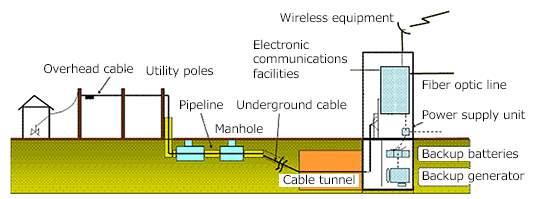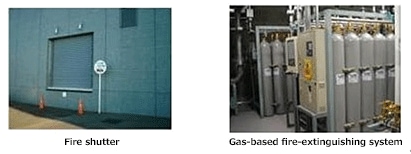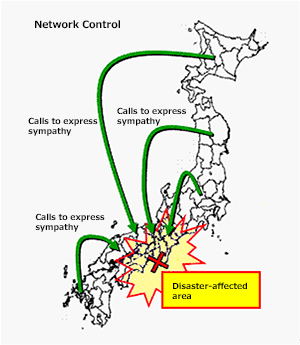NTT DOCOMO BUSINESS’ Disaster Preparedness Initiatives
NTT DOCOMO BUSINESS has built a disaster-resistant telecommunications network to ensure critical communications during disasters and to facilitate the rapid restoration of failed communications services, if any, during such periods. As a designated public institution in Japan, NTT DOCOMO BUSINESS works closely with administrative agencies and local governments to implement various initiatives to maintain communications continuity at all times.
Three Basic Principles of Disaster Preparedness
NTT DOCOMO BUSINESS is constantly striving to improve the reliability of its telecommunications system to ensure that partial disruptions in the system do not significantly affect the overall system.
NTT DOCOMO BUSINESS' relay transmission paths use multiple routes throughout the country, ensuring that even if one route is affected by a disaster, the system can automatically switch to alternative routes to maintain the availability of communication services.

Multi-routing network
1-2. Duplication and Decentralization
1-3. Measures to Improve Reliability
NTT DOCOMO BUSINESS continually enhances the physical strength of its facilities and builds highly reliable communications infrastructure capable of withstanding disasters and other challenges.
Wind and Water-related Disasters
- Measures to protect against floods, ocean tides and heavy snow, including the use of waterproof panels and walls to protect machine rooms
- Wind-pressure designs to enable buildings to withstand typhoons
Fire Prevention
- Fire shutters and fire doors to prevent the spread of fires
- Gas-based fire-suppression systems installed in rooms housing electronic communications equipment
- Flame-retardant and fire-resistant cables to prevent fires
Earthquake Resistance (Indoor Equipment)
- Seismic racks and other measures to withstand a quake registering 7 on Japan’s seismic-intensity scale

NTT DOCOMO BUSINESS is steadily improving its buildings in terms of equipment (power supply, air conditioning, etc.) and access control (entry/exit) to ensure appropriate security levels for the IT age.

Fire prevention and resistance are priorities in all buildings operated by NTT DOCOMO BUSINESS.
Fireproofing of exterior walls against surrounding fires
- Fire shutters and doors
Gas-based fire suppression systems in machine rooms
Fire-retardant and fire-resistant cables

Seismic measures are taken to maintain communications during major earthquakes.
Communication Buildings
- Built to withstand a quake registering 7 on Japan’s seismic-intensity scale, such as the Great Hanshin-Awaji Earthquake
- Seismic-resistant telecommunications equipment, racks, etc.
Power-generation Equipment Systems
- Water supply for system startup as well as fuel lines
Storage Batteries
- Seismic-resistant racks for sealed storage batteries and liquid lead-acid batteries.
Underground Pipelines
- Seismic reinforcement of connection points
NTT DOCOMO BUSINESS maintains a highly reliable backup system consisting of batteries, emergency engines and power-supply vehicles for use during prolonged power outages due to disasters (see routes 1 to 4 below).

NTT DOCOMO BUSINESS has extensive measures in place to ensure that critical communications can be maintained during disasters.
2-1. Ensuring Communications for Organizations Directly Involved in Securing Lifelines
When disasters are reported on television and other media, typically there is an immediate influx of phone calls from people nationwide seeking information or expressing sympathy. To alleviate congestion and ensure uninterrupted phone communications with the affected area, measures are taken to control remote exchanges, such as limiting the number of calls at a given time.

2-3. Disaster Message Hotline (171)
NTT DOCOMO BUSINESS makes every effort to quickly restore telecommunications facilities and services damaged by disasters.
In the event of an ongoing or potential emergency requiring special measures to maintain communications, NTT DOCOMO BUSINESS will establish emergency-response units according to the scope and nature of each situation.
|
Response Unit |
Function |
|---|---|
|
Disaster Response Headquarters |
|
|
Earthquake Disaster-alert Headquarters |
|
|
Information Coordination Office |
|
During both actual and potential emergencies, disaster-response equipment is deployed to protect telecommunications infrastructure and prevent damage from spreading.
|
Disaster-response Equipment |
Purpose |
|---|---|
|
Power facilities |
Provide power during extended power outages due to a disaster, etc. |
|
Emergency cables |
Restore communications in the event of a cable break or related emergency |
|
Satellite mobile phones |
Provide uninterrupted communications when fixed and/or mobile networks are disrupted due to disaster |
|
Helicopters |
Arranged under exclusive contract to transport personnel, materials and equipment to inaccessible areas |
3-3. Periodic Disaster Drills

 EN
EN